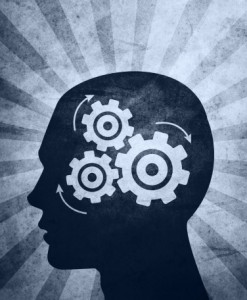The Executive System: Cognitive Science and Kabbalah (Part 3)
By Asher Crispe: September 5, 2012: Category Inspirations, Quilt of Translations
Organizations of the Mind
 What once went wrong often continues to go wrong unless we gain some insight that shifts our perspective and allows us to approach the problem in a new way. Undoubtably, the loss of self-mastery associated with the event of eating from the Tree of Knowledge keeps repeating itself over and over until today. As we explained, the mind (Adam/Adom) ideally remains above the heart (Eve/Chava) and rules over it. The heart (Eve/Chava) in turn maintains the upper hand over the behavioral instincts (snake). Then we get to be the ‘king.’ So what happened in our original Edenic drama? We broke rank and flipped over the control-flow within the soul.
What once went wrong often continues to go wrong unless we gain some insight that shifts our perspective and allows us to approach the problem in a new way. Undoubtably, the loss of self-mastery associated with the event of eating from the Tree of Knowledge keeps repeating itself over and over until today. As we explained, the mind (Adam/Adom) ideally remains above the heart (Eve/Chava) and rules over it. The heart (Eve/Chava) in turn maintains the upper hand over the behavioral instincts (snake). Then we get to be the ‘king.’ So what happened in our original Edenic drama? We broke rank and flipped over the control-flow within the soul.
The transgression was a transgression of the natural order. Initiative came from the bottom of the psychic food chain. The snake cons Chava (Eve) into eating and then she goes on to convince her husband Adom (Adam). This playing of musical chairs with the seats of power in the soul has devastating consequences. When we allow ourselves to be ruled by habit, when we do things by rote or by automatic response, when life becomes formulaic or an endless repetition of self-similitude, it’s a sign that the snake is taking over. And this snake’s bite is poisonous. Its poison stops the heart and then proceeds to sap away all the vital energy that circulates within the organs, limbs and veins of self.
This ‘heart attack’ cannot be contained but quickly precipitates a stroke. Chava (Eve) feeds the negativity to Adom (Adam). Our thoughts are ever vigilant of our emotions. Any reports of heart failure picked up by our early warning stations immediately trigger an alarm. Panic spreads throughout the brain. Our higher-order functions begin to shut down. Likewise, just as the brain needs blood pumped from the heart to function, so too I can’t think because I can’t feel. Prevailing habits may produce emotional apathy and cognitive disinterest.
On the other hand, if the heart remains above the liver, then my actions are not machine like. I perform with feeling. We simultaneously want to invest feeling into our actions so that they will be inspired performances. The same goes with the heart-brain dynamic. While we don’t want to begin with the emotions, for then all our intellectual effort would amount to nothing more than rationalizing, we do want to generate an emotional response. We desire to feel the impact of our thinking. Would emotion dictate the terms of thought, the thought would likely be miscarried. If, however, the mind remains unsubjected to emotional interference, it can operate with clear consciousness. This is not to say that it can ever be fully separated. As one would expect with a married couple, we may not be able to discern where thought leaves off and emotion begins.
In sum, our reformulation of this primal ‘disorder’ would read liver (kaved כבד) over heart (lev לב) over mind (moach מח) so that collectively the acronym that they spell is k’lum (כלם) which means ‘nothing.’ When ordered correctly, we are the melech (the King) but when our inner world goes upside down we quickly turn into ‘nothing.’ Since Rosh Hashanah is the holiday dedicated to reaffirming the kingship of the King, it follows that each of us has to do this personally.
Another alternative worthy of consideration–one which is not as decimating to our mental health, but still proves problematic–is where the heart rules over the mind which then rules over the liver. In this instance, the mind is held hostage to the emotional dictates which skew our thoughts. I may be able to still think. But I may lose the ability to think clearly. I might lose my cool and become ‘hotheaded.’ In this formulation we have heart (lev לב) over mind (moach מח) over liver (kaved כבד) which produces an acronym which reads lemek a nickname for a ‘buffoon’ or ‘clown.’
One might question the literalness of these arrangements. It is an age-old debate as to whether or not emotions are really in our heart or instincts in our gut or liver. The argument intensified for a non-literal reading of this arrangement with the advent of medical marvels such as organ transplants. If a person gets a new heart does it mean that he or she will feel differently? Are the donor emotions also transplanted? Will I cease to be me with a new liver from someone else?
In the Chabad Chassidic tradition, there is a tendency to see all of these control centers from the standpoint of cognitive psychotherapy. The emotions and behavioral instincts are all in the mind. It’s all psychosomatic. What would be the root of the emotions in the mind? Perhaps the sensations in my heart are only felt there because the flesh of that muscle serves as the screen upon which my mind-emotions are projected. The same goes for the gut or liver.
 Kabbalah gives a beautiful illustration of this phenomenon. Each of the three seats of power emanates from the first one. And truthfully they are all in the mind. Chochmah or wisdom is the mind in the mind. Binah or understanding is the heart in the mind. And finally, Da’at or knowledge is the liver within the mind. If we examine the three final letters in the Hebrew words for mind (מח), heart (לב) and liver (כבד) they spell out the word Chabad (חב’ד) which itself stands for the three cognitive faculties of wisdom (chochmah חכמה), understanding (binah בינה) and knowledge (da’at דעת).
Kabbalah gives a beautiful illustration of this phenomenon. Each of the three seats of power emanates from the first one. And truthfully they are all in the mind. Chochmah or wisdom is the mind in the mind. Binah or understanding is the heart in the mind. And finally, Da’at or knowledge is the liver within the mind. If we examine the three final letters in the Hebrew words for mind (מח), heart (לב) and liver (כבד) they spell out the word Chabad (חב’ד) which itself stands for the three cognitive faculties of wisdom (chochmah חכמה), understanding (binah בינה) and knowledge (da’at דעת).
Subsequently, if we want to fix a gut or heart problem we best start by looking in the mind. If we are to rectify our emotions or behavior we’d best begin by changing our mind (Rosh Hashanah). A changed body begins with a changed mind, just as a changed year begins with a changed read of the year.
For Part Four in our series we will return to the right-left dynamics as they pertain to our current cast of characters from this Edenic drama.
The Executive System: Cognitive Science and Kabbalah (Part 3),























;)
;)
;)
;)
;)
;)
;)
;)
;)
;)
